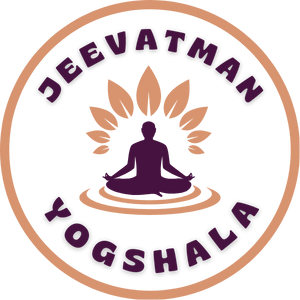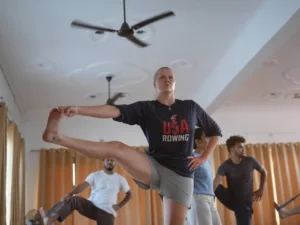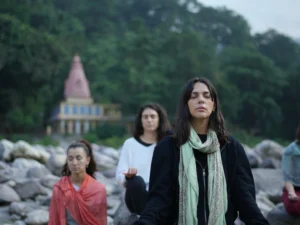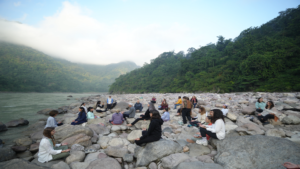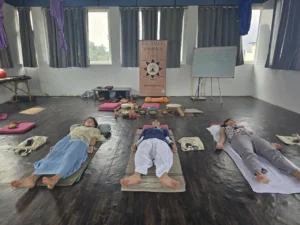Interested in learning this at our Rishikesh Yoga Retreat? → Contact us
Unlocking the Power of Supta Vajrasana: Benefits, Steps, and Precautions
In Sanskrit, “Supta” translates to “lying down” or “reclining,” while “Vajra” means “diamond” or “thunderbolt.” “Asana” simply means posture. Together, Supta Vajrasana is known in English as the Sleeping Thunderbolt Pose. A close variation of this pose is Supta Virasana, also known as the Reclining Hero Pose.
Pose Overview
- Position: Supine (lying on your back)
- Pose Type: Reclining
- Spiritual Activation: Mooladhara (Root Chakra), Manipura (Solar Plexus), Vishuddhi (Throat Chakra)
- Physical Focus: Thighs, groins, knees, ankles, abdomen, shoulders
- Best Suited For: Pitta dosha types
- Recommended Preparatory Asanas: Baddha Konasana, Balasana, Bhujangasana
How to Practice Supta Vajrasana
Start by sitting in Vajrasana with your arms behind you, fingertips pointing toward your hips. Slowly exhale and lean back, lowering onto your left forearm first, then the right.
Once both elbows are on the ground, gently ease your back down. Support your lower back with your hands until your upper body touches the floor and the crown of your head is relaxed. In the final position, rest your hands on your thighs or above your head, holding opposite elbows.
Stay here for 30 seconds to 1 minute, breathing deeply. To exit, inhale, use your elbows to support yourself up, return to Vajrasana, and only then stretch your legs out.
Tip: Beginners may use a folded blanket under the knees for support. Keep your thighs parallel and avoid letting the knees splay wider than the hips.
Beginners who struggle with backbends often benefit from preparing with forward bends like
Janu Sirsasana, which helps open the hamstrings and lower back.
Supta Vajrasana Benefits
Practicing Supta Vajrasana regularly can offer a wide range of physical and therapeutic benefits. Here’s a closer look at some of the most well-known Supta Vajrasana benefits:
- Stretches thighs, abdomen, knees, and hip flexors
- Strengthens arches and tones spinal nerves
- Enhances flexibility in the lower body
- Boosts oxygen intake by expanding the chest
- Massages abdominal organs and supports digestion
- Redirects energy for spiritual focus and meditation
- Supports healthy blood circulation and relieves tired legs
Among the top Supta Vajrasana benefits, one of the most appreciated effects is its calming nature—it helps balance the fiery energy of the Pitta dosha and encourages emotional grounding.
Therapeutic Supta Vajrasana Benefits
Many practitioners experience therapeutic relief with Supta Vajrasana, including improvements in:
- Headaches and insomnia
- Asthma, bronchitis, and other respiratory issues
- Menstrual discomfort and infertility
- Constipation, acidity, and digestive imbalance
- Varicose veins and sciatic pain
- Flat feet and tired legs
Because of its calming effect on the nervous system and subtle energy channels, this posture is often recommended as part of restorative yoga sequences.
Safety & Precautions
While Supta Vajrasana offers profound benefits, it’s important to practice it mindfully:
- Never exit the pose by straightening the legs first—this can harm the knees. Always return to Vajrasana first.
- Avoid the pose if you have:
- Serious knee or ankle injuries
- Severe back problems
- Constipation or sciatica
Final Thoughts
Whether you’re looking to deepen your flexibility, calm your nervous system, or balance your inner fire, the Supta Vajrasana benefits are both grounding and expansive. Like many traditional poses, its effects go beyond the physical—offering peace, stillness, and a space for inward reflection.
Let me know if you’d like this adapted for a website/blog format, or want a shorter version for Instagram or YouTube description!
Want to explore and master traditional poses like Supta Vajrasana?
At Jeevatman Yogshala, all these ancient asanas — including Supta Vajrasana, Bhujangasana, and Balasana — are deeply taught and practiced as part of our 200 Hour Yoga Teacher Training in Rishikesh program.
It’s a complete journey into yoga philosophy, alignment, anatomy, and daily practice to help you become a certified Yoga Alliance teacher.
Want hands-on guidance? Book a free 15-minute posture review with our teacher
Supta Vajrasana is often taught in restorative yoga sessions. If you want a deeper healing experience in Rishikesh, check our 7-Day Restorative Yoga Retreat.
Students who struggle with back bending or knee flexibility often improve faster with guided sound therapy. Learn more about our Sound Healing Course in Rishikesh where we combine breathwork, relaxation, and yogic practices for healing.
